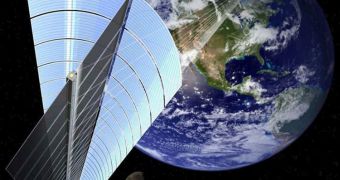In a new report, entitled “Energy Horizons: United State Air Force Energy S&T Vision 2011-2026,” the USAF lists all of its technological needs for the next 15 years. Also included in the document is the organization's vision for the future of energy sciences, both for terrestrial and deep space applications.
This report can be thought of as a forecast of the things the USAF expects to be made available in the short-term. Some of the plans listed within call for the construction of power stations in Earth's orbit, which could potentially help fuel outbound spacecraft.
In addition, future satellites and probes should be fueled by small nuclear reactors, the document indicates. This would ensure a much longer range and autonomy, while at the same time allowing the vehicles to move extremely far away from the Sun without running out of power.
In addition to covering the mission that the USAF has in space and in the air, the report also included guidelines for how the organization should handle issues related to cyberspace and infrastructure.
The new strategy is the result of a series of meeting and workshops featuring numerous high-profile scientists, Space reports. The document was released on February 9, 2012, but has been made available to the general public only recently.
“Energy is a center of gravity in war and an assured energy advantage can enable victory. While energy is already an essential enabler, global competition, environmental objectives and economic imperatives will only increase its importance,” says the leader of the team that compiled the report, Mark Maybury.
The official is the chief scientist for the United States Air Force. He and his team wrote in their report that space is the “ultimate high ground,” especially in strategic and military terms. This is why parts of the document focus so heavily on the need to make high-tech advances in exploring space.
For example, current solar arrays aboard satellites can only provide up to 27 kilowatt (kW) of power to spacecraft. This is insufficient for the type of applications the USAF, NASA, and agencies in charge of national security are interested in.
“Employing larger and more efficient arrays will enable missions that require very high power, such as space-based radar or space-based laser missions,” the new report explains. Future on-orbit power generation technologies should be able to produce at least 500 kW of power.
Harvesting energy from Earth's geomagnetic field is also an avenue of research worth exploring, the team behind the new document believes.
“Energy is essential to all Air Force missions. Improving energy efficiency, reducing demand and changing the culture is vital to mission success,” Secretary of the Air Force Michael Donley and Air Force Chief of Staff Gen. Norton Schwartz say in a letter on the cover of the new report.

 14 DAY TRIAL //
14 DAY TRIAL //